Impact of Surface Chemistry on the Excited State Interactions of CsPbBr3
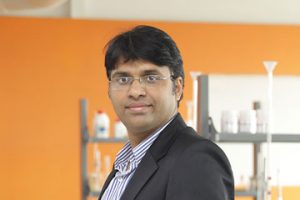 Dr Nimai Mishra, Assistant Professor, Department of Chemistry, SRM University-AP along with his team comprising of his PhD scholars Mr. Syed Akhil, Ms. V.G.Vasavi Dutt, and Mr Rahul Singh have published a research article titled “Surface-State-Mediated Interfacial Hole Transfer Dynamics Between CsPbBr3 Perovskite Nanocrystals and Phenothiazine Redox Couple” in The Journal of Physical Chemistry-C, published by The American Chemical Society with an impact factor of ~4.126.
Dr Nimai Mishra, Assistant Professor, Department of Chemistry, SRM University-AP along with his team comprising of his PhD scholars Mr. Syed Akhil, Ms. V.G.Vasavi Dutt, and Mr Rahul Singh have published a research article titled “Surface-State-Mediated Interfacial Hole Transfer Dynamics Between CsPbBr3 Perovskite Nanocrystals and Phenothiazine Redox Couple” in The Journal of Physical Chemistry-C, published by The American Chemical Society with an impact factor of ~4.126.
Dr Mishra’s research interests lie in Semiconductor nanocrystals, Core/shell branched structures, Nanowires, Perovskite nanocrystals and Optoelectronic device fabrication. He studied the role of surface chemistry for improving excited state hole transfer from CsPbBr3 nanocrystals to an acceptor, potentially applicable for photocatalytic applications.
About the research:
 Recently, caesium lead bromide (CsPbBr3) perovskite nanocrystals (PNCs) gained enormous attention for designing photocatalytic reactions because of their photocatalytic properties. But the surface chemistry of nanocrystals is often ignored which dictate the excited state interactions of these semiconductor nanocrystals with the charge shuttling redox-active molecules. In this work, we have explored the impact of CsPbBr3 perovskite nanocrystals with the three different surface chemistries on the excited state interactions with the standard hole acceptor phenothiazine molecule. From the steady PL-lifetime decay measurements we have calculated the photoinduced hole transfer (PHT). In the amine-free PNCs case, PHT is 6 times higher than the conventional amine capped ligands. Using the lifetime fast component (1) rate constants, we have calculated the hole transfer constant (kht) which is 3.942 × 108 s-1 and it is 4 times higher in amine-free ligands when compared with conventional amine ligands system.
Recently, caesium lead bromide (CsPbBr3) perovskite nanocrystals (PNCs) gained enormous attention for designing photocatalytic reactions because of their photocatalytic properties. But the surface chemistry of nanocrystals is often ignored which dictate the excited state interactions of these semiconductor nanocrystals with the charge shuttling redox-active molecules. In this work, we have explored the impact of CsPbBr3 perovskite nanocrystals with the three different surface chemistries on the excited state interactions with the standard hole acceptor phenothiazine molecule. From the steady PL-lifetime decay measurements we have calculated the photoinduced hole transfer (PHT). In the amine-free PNCs case, PHT is 6 times higher than the conventional amine capped ligands. Using the lifetime fast component (1) rate constants, we have calculated the hole transfer constant (kht) which is 3.942 × 108 s-1 and it is 4 times higher in amine-free ligands when compared with conventional amine ligands system.
According to Dr Nimai Mishra, the most important contribution of this research is that these results highlight the impact of surface chemistry on the excited state interactions of CsPbBr3 PNCs and conclude amine-free PNCs could be an ideal candidate for photocatalytic reactions.
Read the full paper: https://pubs.acs.org/doi/10.1021/acs.jpcc.1c07129
- Published in Chemistry-news, News, Research News
Securing Online Payments made through Wearable Devices
Smart devices and Internet of Things (IoT) are growing in importance every day and so do our security concerns about using them for our financial transactions. As we carry the world with us through wearable technology, Dr Sriramulu Bojjagani, Assistant Professor, Department of Computer Science Engineering works towards making wearable devices more secure.
With a thriving interest in Cyber Security, Formal Verification Methods and Vulnerability Analysis and Penetration Testing, Dr Bojjagani has recently published his paper on “A Secure IoT-based Micro-payment Protocol for Wearable Devices” in Peer-to-Peer Networking and Applications (PPNA), Springer.DOI: 10.1007/s12083-021-01242-y
Abstract:
Wearable devices are one of the parts of the essential cost of goods sold (COGS) in the wheel of the Internet of things (IoT), contributing towards a potential impact in the finance and banking sectors. There is a need for lightweight cryptography mechanisms for IoT devices because these are resource constraints. This paper introduces a novel approach to an IoT-based micro-payment protocol in a wearable device’s environment. This payment model uses “elliptic curve integrated encryption scheme (ECIES)” for encryption and decryption of the communicating messages between various entities. The proposed protocol allows the customer to buy the goods using a wearable device and send the mobile application’s confidential payment information. The application creates a secure session between the customer, banks, and merchant. The static security analysis and informal security methods indicate that the proposed protocol is withstanding the various security vulnerabilities involved in mobile payments. For logical verification of the correctness of security properties using the formal way of “Burrows-Abadi-Needham (BAN)” logic confirms the proposed protocol’s accuracy. The practical simulation and validation using the Scyther and Tamarin tool ensure the absence of security attacks in our scheme. Finally, the performance analysis based on cryptography features and computational overhead of related approaches specify that the proposed micro-payment protocol for wearable devices is secure and efficient.
Architecture for wearable devices:
The architecture for wearable devices is shown in Fig. 1. It consists of six types of entities, such as Issuer bank (IB), acquirer bank (AB), payment gateway (PG), a certification authority (CA), mobile terminal, and wearable sensing devices. The person using various wearable devices such as a smartwatch, smart wristband, smart glass, etc. In the architecture, a wearable device is connected to the mobile terminal through NFC. An app is running on a mobile device. Wearable devices are resource constraints because they have limited computing capabilities regarding battery, display, storage, and processing compared to a mobile terminal (smartphone). Hence, NFC is used to pair the wearable device and mobile terminal for transmitting public messages. Before conducting any transaction with the merchant, the customer and merchant should register their mobile numbers with the bank.
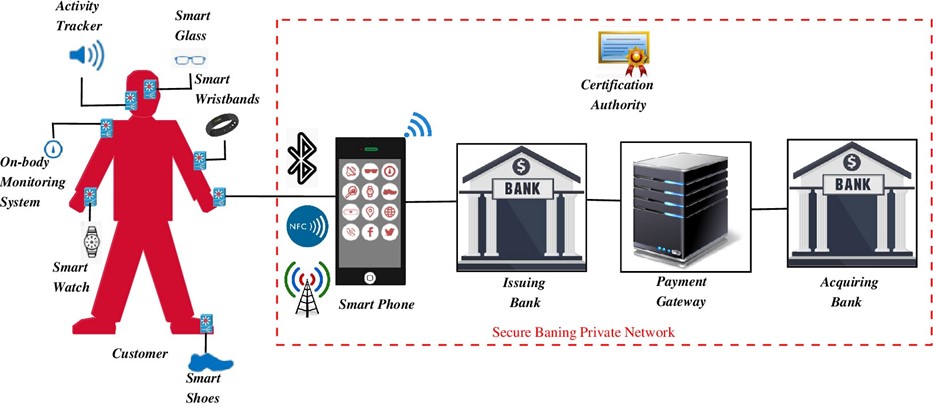
Fig. 1. Architecture for wearable devices
The customer can place an order with the merchant using the following steps and the complete messages flow in the proposed protocol is shown shown in the Figure.
● The customer places an order for an item through a wearable device.
● The request is transferred to the mobile app. The mobile app verifies the user authentication.
● After a successful authentication request, the app forwarded the request to the issuing bank for payment verification.
● The customer also sends a payment request for a deduction of the amount from his/her issuing bank.
● Once the bank validates the customer data in terms of sufficient funds available and user’s integrity. The issuing bank routes the transaction to the payment gateway through a secure network.
● In this step, the payment gateway verified the customer payment order and transferred it to the acquiring bank.
● If all the verifications are successful, then the transaction amount is then debited from the issuing bank and credited to the merchants’ acquiring bank.

Application demonstration:
As we know, most wearable devices run the Android operating system. The proposed framework developed as an Android application package (APK) file run in an Android wearable emulator, but we have operated in the Samsung Galaxy Note-2 device due to limits of the screen device and lack of environment. First, it needs to install the APK file and start running the app. Before running the app, some points need to be considered, such as the following:
● The company voice gateway provided for the service of an SMS gateway connected to Xeon server and assigned us a shortcode 56677.
● The payment gateway switch is used to communicate with the customer and merchant bank accounts.
● Two mobile numbers are registered with the banks and telecom operations, and it is used for SMS service.
● The deployed decryption web application on the Xeon server.
● HTTPS connection is used between voice gateway and Xeon server established Indian financial network (INFINET) link between server and bank.
We have not mentioned all the screenshots for the app from starting the login and authentication phase, but the protocol requires the essential information only shown in the screenshot. We didn’t mention the banks considered for implementing the micro-payment protocol for security and reputation reasons.
The proposed protocol action is as follows:
Step 1: The customer x runs a wearable application to enter Wearable-id, mobile number, pin and amount and sends an encrypted message to the Xeon server via short-code 56677. To encrypt the message, the customer may choose any one of the ECC curves as shown in Fig. 2.

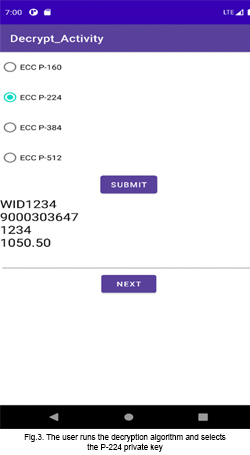
Step 2: The SMS gateway receives the encrypted SMS, which is delivered to the server
Step 3: The server receives the encrypted SMS and executes the decryption application. Next, the user runs decryption activity and selects the P-224 private key. After decryption, the message is shown in Fig. 3.
Step 4: After the message is decrypted, the user presses the “Next” button to communicate with the payment gateway.
Step 5: Now, the merchant fills in the remaining fields of merchant UPI-id, mobile number, and purpose of payment and then selects any payment gateway as shown in Fig. 4.

Fig. 4: The merchant enters the details and sends to any payment server
Dr Bojjagani’s research will further refine the parameters of security in IoT enabling wearable devices to become smarter and safer.
- To make the proposed protocols more secure can add biometric-based authentication can be added.
- The future directions of the proposed framework fit only for micro-payments. In future, we have upgraded to credit card/debit card payments to enhance the proposed framework for macro-payments.
- Published in CSE NEWS, News, Research News
Exciting dream salary in dream company BARCLAYS
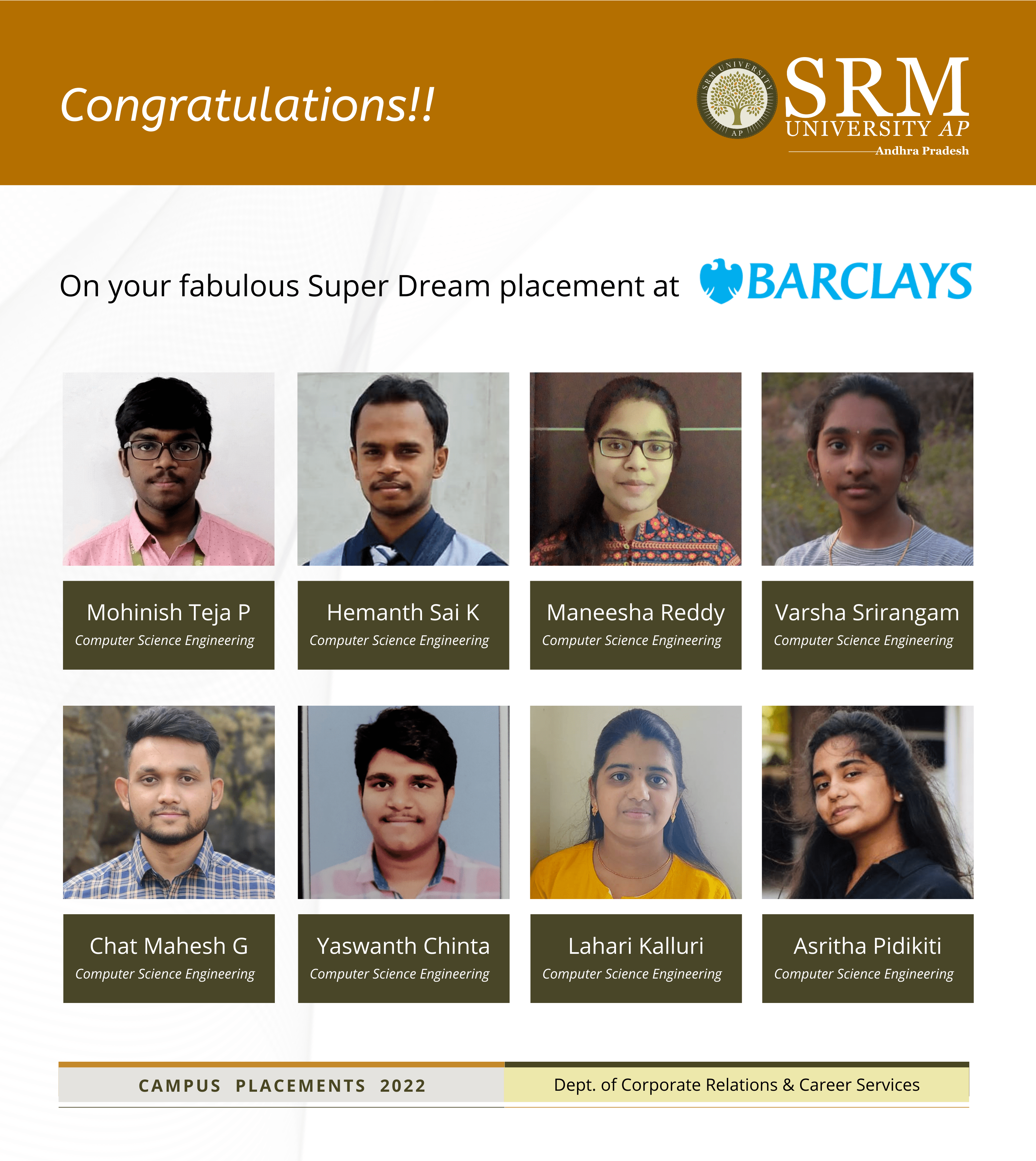 8 students with exciting job offers to their name from world-renowned Barclays Multinational Bank shine up on SRM University-AP banner. Thriving in a competitive environment and levelling themselves up with their goals, these students were able to not only show their polished skills but also their refined mannerisms at expressing it. Their smart work at making best use of the versatile courses offered to them by SRM University-AP has helped them land the job of their dreams.
8 students with exciting job offers to their name from world-renowned Barclays Multinational Bank shine up on SRM University-AP banner. Thriving in a competitive environment and levelling themselves up with their goals, these students were able to not only show their polished skills but also their refined mannerisms at expressing it. Their smart work at making best use of the versatile courses offered to them by SRM University-AP has helped them land the job of their dreams.
Barclays is a coveted dream company for Engineers in India. The Placement Cell at SRM University-AP, CR&CS (Corporate Relations and Career Services) realizes that for specific job roles specific skills would have to be cultivated and the students would need outstanding training along with their academia to fill these roles. The CR&CS counsels the students accordingly so that by the time they sit for the interview they carry the confidence of being the perfect fit for the role.
Maneesha Reddy
“Stop doubting yourself, work hard and make it happen. This is what SRM University-AP taught me. The ISCP course by the CCC department included in the academics helped me become better every day and improved my skills in coding and logical thinking. The training classes provided for the placement and the talks with the experts organised by the CR&CS department helped me know the overview of the placement process. Faculty members really helped us to improve, especially our HOD, Dr Raghunathan, has been the best support to all things associated with the CSE Department. My advice to my juniors is to stay focused on your work, be confident, and follow the curriculum set by the placement department.”
Gunturu Hemanth Sai Kumar
“SRM University-AP curriculum provided a wonderful environment for building up my basics and it also helped me in achieving higher CGPA. The bootcamps and ISCP classes conducted by CCC department provided me the exposure to different company specific problems and improved my problem-solving skills. Placement department also provided me with opportunities by bringing in various companies and that experience helped me clear the interviews. I even got shortlisted for interviews of Marquee and super dream companies like Wells Fargo, NielsenIQ, Navis, Sabre which provided me great exposure to interview handling skills.”
Asritha Pidikiti
“SRM University-AP is a place where you can find an amalgamation of learning, fun, culture, many such life preaching activities. Various workshops and sessions that were held in the University, improved my technical as well as interpersonal skills. My knowledge and confidence go a boost after coming here. SRM University-AP has given me a chance to participate in various committees which helped me to broaden my network. The placement cell has excellent policies and has exceptionally helped me build an industry-ready profile, by arranging seminars and holding aptitude- development lectures.”
Chinta Yaswanth
“I am very glad to start my career with Barclays This could come to pass because CR&CS dept supported us a lot by conducting multiple mock tests. Especially, thanks to the company specific sessions before the drive. These sessions before the drive made all the difference and assured us to face an interview. I whole-heartedly appreciate the virtual help desk despite of the covid situation. I would suggest my juniors to be good at their basics and follow the inputs given by placement team.”
Kalluri Lahari
“You never change your life until you step out of your comfort zone; change begins at the end of your comfort zone.
“I still remember when I joined this university, being a person who used to be shy and introvert, and today, I am here holding an offer would not have been possible without the support from SRM University-AP. The coursework provided by CR&CS department, CDC and domain training helped me to achieve this offer. The CDC department guidance assisted us in improving communication skills and teamwork. Approximately 65 companies lined up for recruitment in a month. SRM University provided us with countless opportunities to fulfil our goals. My advice for the juniors would be to not postpone everything to the last-minute because this might stop you from achieving your dreams.”
Srirangam Varsha
“The curriculum containing industry specific training, mock interviews and group discussions along with company specific training made it easier for us throughout the placement drive. We were familiar with the concepts asked in our coding and interview rounds thanks to the training sessions provided by the CR&CS department. The encouragement I received from my faculty and mentor really helped me when I was at my lowest. I would like to take this chance to thank all my faculty, seniors and CR&CS department because of whose help I did not feel any burden throughout my placement drive and achieved great results. I would suggest to my juniors to take advantage of inputs provided by management to fulfil your dreams and achieve higher heights.”
Paturi Mohinish Teja
“I am very happy to get placed at Barclays. I used to dream about getting placed at a FinTech institution and am very glad to achieve it. Curriculum at SRM University-AP helped me in learning all the required computer fundamentals. CCC training organised by the placement department has helped me a lot during my preparation for placements and interviews. I have been part of Next Tech Lab, which helped me learn a lot of things and build many projects. These projects helped me in Interview. My advice to Juniors would be to build a strong portfolio and never give up in the middle.”
SRM University-AP is proud of their achievements and would like to wish them all the success in their lives as their alma-mater.
- Published in News
World’s top 2% scientists by Stanford University include faculty from SRM University-AP
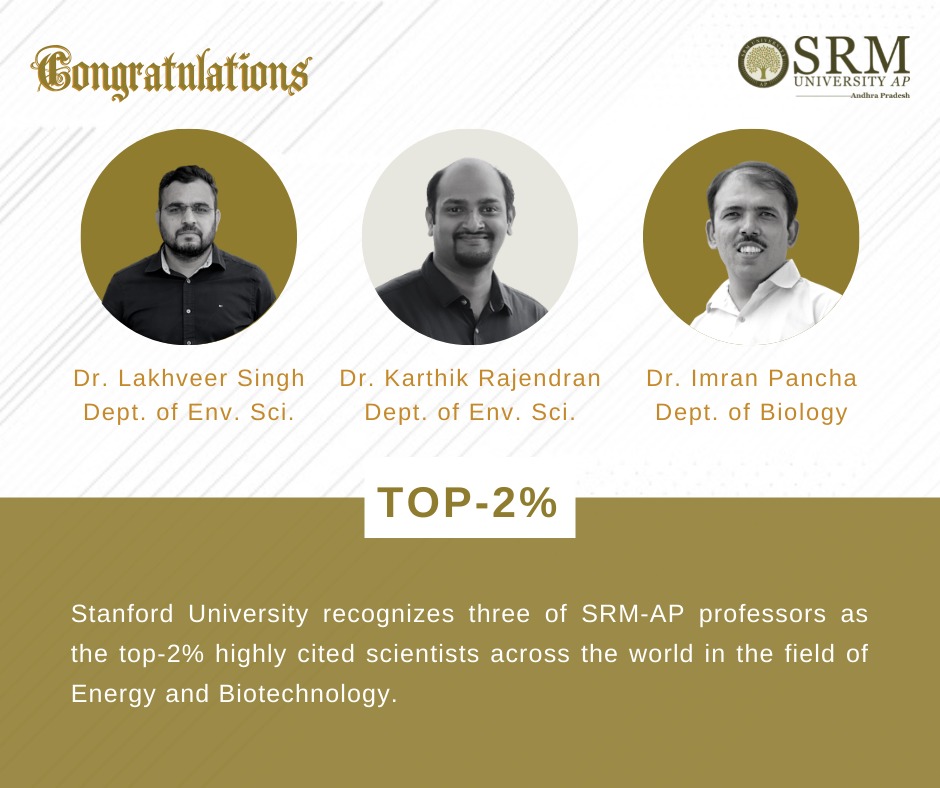 Dr Karthik Rajendran, and Dr Lakhveer Singh from the Department of Environmental Science and Dr Imran Pancha from the Department of Biological Sciences of SRM University-AP are enlisted on the global list of the top 2% of scientists, the data compiled by Stanford University.
Dr Karthik Rajendran, and Dr Lakhveer Singh from the Department of Environmental Science and Dr Imran Pancha from the Department of Biological Sciences of SRM University-AP are enlisted on the global list of the top 2% of scientists, the data compiled by Stanford University.
Stanford University has identified Dr Imran Pancha as one of the 91 scientists who has excelled in research in the fields of biotechnology among all the universities in India. Dr Imran Pancha was recognised as one of the top 2% scientists in the world in the year 2020 also. Stanford University recognized 178 scientists who excelled in research in the field of energy, which includes Dr Karthik Rajendran and Dr Lakhveer Singh among the top 2 per cent of scientists. The quality of research work, its societal impact, number of publications, citations, are taken into consideration for this recognition.
University Vice-Chancellor Prof V S Rao and Pro-Vice-Chancellor Prof D Narayana Rao presented Certificates of Recognition to the three professors at a congratulatory function held at the university on Friday. “This is an admirable achievement that young faculty from a nascent University appear in the top 2% scientists of the world,” said Prof D Narayana Rao. Prof V S Rao Narayana Rao appreciated their talent and efforts. Prof Narayana Rao assured them that the university would provide the necessary comprehensive support for carrying out research in front-line and emerging areas. Prof Narayana Rao further said that he is very confident that many more faculty members of SRM University – AP, will receive such global recognition in the years to come.
- Published in Biology News, Departmental News, ENVS News, News

